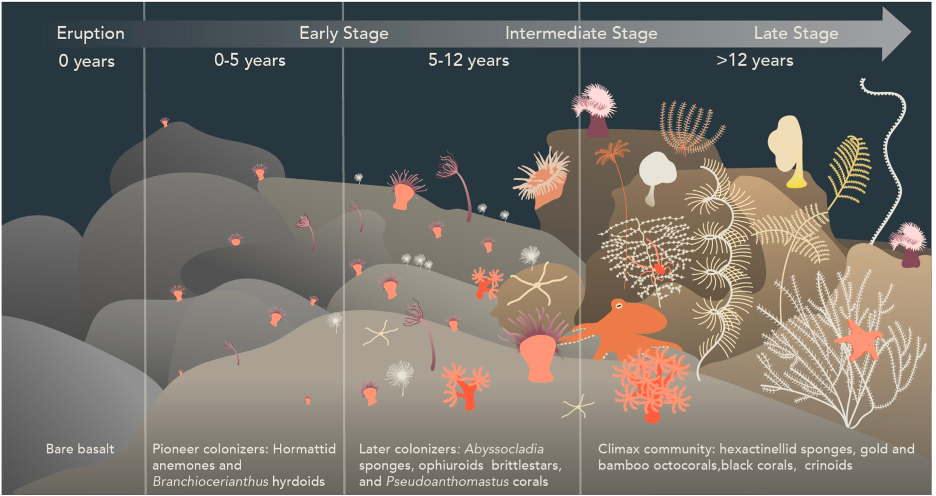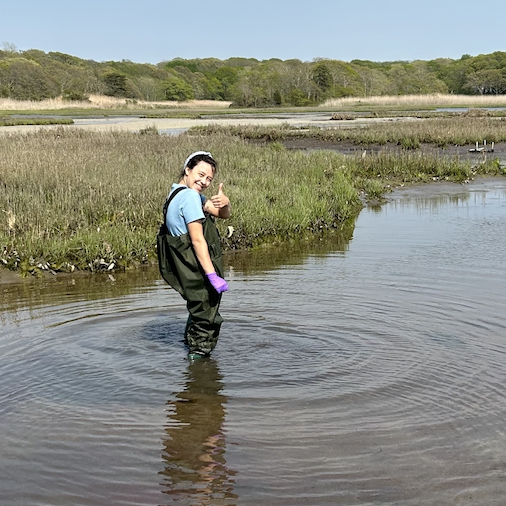Herrera, S., Chadwick, Jr., W. W., Jackson, M. G., Kontor, J., McCartin, L., Pittoors, N., Bushta, E., & Merle, S. G. (2023). From basalt to biosphere: Early non-vent community succession on the erupting Vailulu’u deep seamount. Frontiers in Marine Science. https://doi.org/10.3389/fmars.2023.1110062
Eyes on the Seafloor
Ecological succession is the process by which organisms inhabit an area after it has been disturbed. Understanding this process is vital, since resilience and recovery is key to an ecosystem’s survival. The deep sea is an excellent place to study ecological succession; since life on the seafloor is so closely tied to geological events that disrupt ecosystems, scientists can monitor biological and geological changes in tandem. One such environment is Vailulu’u, an active seamount – or underwater volcano – in waters of American Samoa.
Vailulu’u is a vast and nuanced site. Its peak reaches 590m, while the foot of the seamount lies at a depth of 1050m. The summit is marked by a crater that stretches over 2,000 meters wide and hosts several vent fields which are fueled by the hydrothermal activity within the seamount. And, like many seamounts, Vailulu’u is an underwater oasis for life.
Life on much of the seafloor is long and slow-growing. Coral succession, for instance, can span decades, and even millennia. Fortunately, Vailulu’u has been well documented by oceanographers for years. Long-term monitoring of the seamount has revealed changes to its geologic structure over time, and with it, changes to the community structure.
Spotting Sucession
In order to analyze the ecological changes on Vailulu’u, scientists used bathymetric maps and remotely operated vehicles (ROVs). Bathymetric data indicates the ocean’s depth, and since volcanism can generate new and altered seafloor, changes to depth will reveal geologic activity. By examining the changes to the seafloor over time, geologists can date the age of the different zones along the seamount. Meanwhile, ROVs, which are fitted with cameras, were used to acquire footage from the seamount. By reviewing the videos collected at Vailulu’u, biologists were able to identify megafauna inhabiting the seamount. By pairing this data to the bathymetric maps, researchers were able to identify when certain animals inhabited the area relative to the disturbance caused by volcanic activity.
Researchers found that the number of species, the abundance of life, and the size of the organisms all increased with succession time, following a similar pattern observed at other rich habitats around the globe. In other words, over time, more creatures settle in, growing larger and increasing the biodiversity of their ecosystem. The Branchiocerianthushydroid and hormathiid anemone were among the first species to colonize a recently disrupted area (called “pioneer species”). They were followed by octocorals, sponges, and ophiuroids. Finally, organisms such as hexactinellid sponges and crinoids began to inhabit the seamount.

Looking Ahead…
This study’s findings intrigue geologists and biologists alike. For starters, it reveals that Vailulu’u remains volcanically active. Meanwhile, biologists may be able to learn more about deep sea reproduction from studying ecological succession. For instance, it is possible that early colonizer species play a role in the dispersal of later-stage succession species’ larvae. Perhaps most notably, this time series allows scientists to construct a model of deep sea succession over a several years, providing insight to the long term effects of disruption in the deep sea and the time frame over which recovery occurs.
The seafloor is largely understudied, especially in environments that aren’t driven by hydrothermal venting. While Vailulu’u is hydrothermally active, the majority of its surface aren’t vent fields. Therefore, this study provides rare insight into the ecological succession of an area that isn’t dominated by venting, but remains subject to relatively frequent disturbances. This work is especially important as the threat of deep sea mining and trawling grow larger. As human-driven disruptions grow increasingly commonplace in the deep sea, it becomes more essential than ever to understand the ability of life on the seafloor to respond to and recover from devastating events.
Feature Image Credit: Vailulu’u 2005 Exploration (NOAA Ocean Explorer)

I am a PhD student at Boston University, where I study marine microbial ecology. I am interested in exploring the impact of the unseen on our oceans – my focus lies within the field of environmental microbiology, and the ecosystems that most intrigue me lie on the seafloor. When I’m not around the lab or in the field, I enjoy traveling, music, and theatre.

